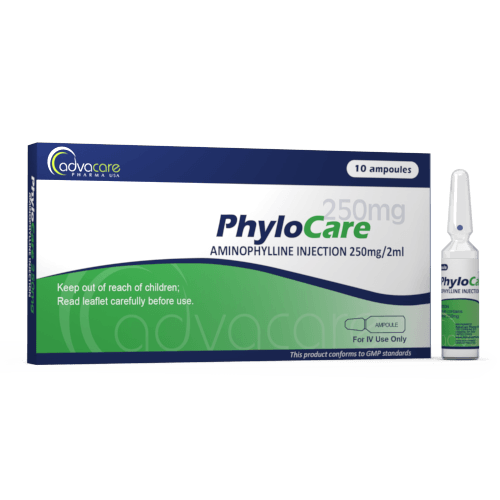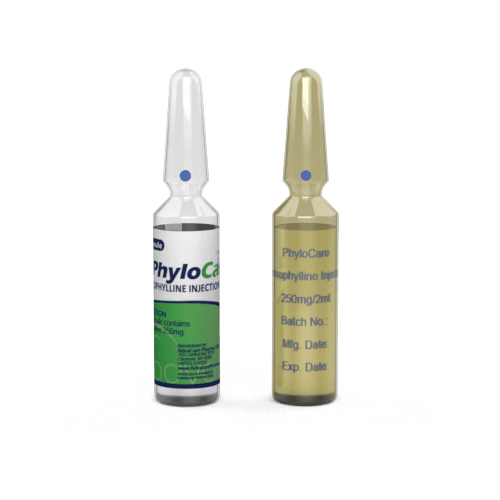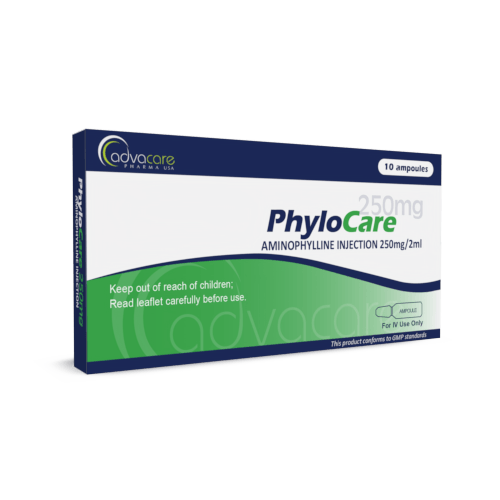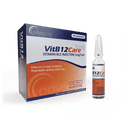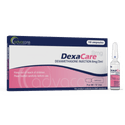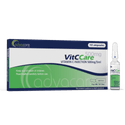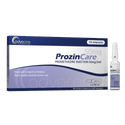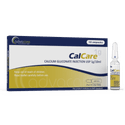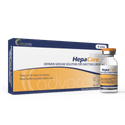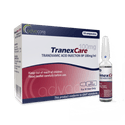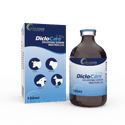- Home›
- Pharmaceuticals›
- Injections›
- Small Volume Injections›
- Aminophylline Injection
Aminophylline Injection
Dosage
Packaging
What is Aminophylline?
Active Ingredients: Aminophylline
Aminophylline Injection is used to prevent and treat reversible airway obstruction caused by lung diseases like asthma, chronic bronchitis, and emphysema. It is effective at reducing symptoms such as wheezing, shortness of breath, and chest tightness. This drug is often used in combination with other medicines.
Injections of Aminophylline are typically used to treat these symptoms within a hospital setting. It can also be used off-label as a reversal agent for nuclear stress testing.
Aminophylline is in the group of medicines called bronchodilators. It works by relaxing and opening the bronchial tubes in the lungs, which makes it easier to breathe.
It is a drug combination that contains theophylline and ethylenediamine in a 2:1 ratio. When Aminophylline enters the human body, theophylline is released and acts as a phosphodiesterase inhibitor, adenosine receptor blocker, and histone deacetylase activator. This drug is an ethylenediamine salt of theophylline. After ingestion, theophylline is released and leads to muscle relaxation of the bronchial airways and pulmonary blood vessels and also reduces the airway response to histamine, adenosine, methacholine, and allergen. The active ingredient inhibits type III and type IV phosphodiesterase (PDE), the enzyme responsible for breaking down cyclic AMP in smooth muscle cells. This results in bronchodilation. The drug also binds to the adenosine A2B receptor and blocks adenosine-mediated bronchoconstriction. When an inflammatory is present, theophylline activates histone deacetylase to prevent the transcription of inflammatory genes that require the acetylation of histones for transcription to begin.
In adults and children over one-year-old, about 90% of the theophylline dose is processed by the liver. For newborns, approximately half of the theophylline dose is passed unchanged in the urine. After the first three months of life, this decreases to about 10%. It is crucial to be cautious with dosing and closely monitor theophylline levels in newborns with reduced kidney function due to the significant portion of the dose excreted unchanged in their urine. Theophylline clearance is around 30% lower in healthy elderly adults (over 60 years old) compared to younger adults. Neonates have very low theophylline clearance, which peaks by age one, remains steady until about nine years old, and then gradually decreases by approximately 50% to adult levels at around 16 years old. While neonates excrete about 50% of the dose unchanged, children over three months and adults only excrete about 10%. Women on the 20th day of their menstrual cycle and during the third trimester of pregnancy may experience a significant reduction in theophylline clearance.
AdvaCare is a GMP-certified producer of Aminophylline Injections. This medication is manufactured in our factories in China, India, and the USA. We routinely inspect our production facilities to ensure our products meet quality and safety standards.
Why are we a leading Aminophylline manufacturer?
AdvaCare Pharma, a US-owned pharmaceutical company, is a manufacturer of Aminophylline Injection with GMP-compliant manufacturing facilities located worldwide. We conduct frequent GMP, third-party and internal facility inspections to ensure that our manufactured injectable treatments exceed the stringent requirements of importing countries and our distributors.
As a renown Aminophylline manufacturer and global supplier of 120+ pharmaceutical injection products, our global reach extends to over 65 markets ensuring that pharmaceutical distributors, hospitals, pharmacies, NGOs and government institutions receive the quality-assured treatments they need.
Uses
How are Aminophylline Injections used?
This medication is manufactured as a solution to be administered through a needle placed in a vein.
What dose should be given?
A physician should prescribe the exact dose and schedule for this medicine. The maximum dose for elderly patients (60 years of age or older) is 400mg/day.
What are the symptoms of an overdose?
Symptoms of overdose include trouble breathing and passing out. Other symptoms of overdose may include generalized seizures and life-threatening cardiac arrhythmias. These symptoms should be reported to a medical professional. If a patient experiences any of these symptoms, seek urgent medical help.
What is the treatment approach for Aminophylline overdose?
The treatment approach depends on the patient’s current health condition. Firstly, the Aminophylline infusion should be stopped, and patients should seek professional advice. Supportive care, including airway maintenance and ECG monitoring, is crucial. If seizures occur, benzodiazepines should be added. If the seizures are repetitive, phenobarbital should be added. If cardiac arrhythmias occur, antiarrhythmic therapy should be added. The serum theophylline concentrations should be regularly monitored. Theophylline clearance can also be achieved with multiple-dose oral activated charcoal and sorbitol if necessary. The decision about the treatment process for overdose should be made by the doctors.
Can everyone be treated with Aminophylline Injections?
No, this drug should be prescribed by professionals and should be used with caution, especially if the patient has some of the following conditions:
- Acute pulmonary edema
- Congestive heart failure
- Cor pulmonale
- Fever
- Hypothyroidism
- Liver disease: cirrhosis, acute hepatitis
- Active peptic ulcer disease
- Seizure disorders
- Reduced renal function in infants <3 months of age
- Sepsis with multi-organ failure
- Cardiac arrhythmias (not including bradyarrhythmias)
- Shock
Age also affects the risks of the drug, and it should be used with caution for the following age ranges:
- neonates (term and premature)
- children younger than 1 year
- older patients (>60 years)
Can pregnant women be treated with this drug?
Animal studies show that this drug does not have teratogenic effects. The drug belongs to the pregnancy category C and should be used with caution if the benefits outweigh the risks. This drug can be excreted into the breast milk and might lead to irritability. Aminophylline might lead to mild toxicity in nursing human infants, and serious adverse effects if the dose is much higher than recommended.
Can this drug be used for pediatric patients?
This drug is safe for pediatric patients, but the dose must be carefully determined by a professional. Patients under the age of one have an immature theophylline metabolic pathway, and the dose must be carefully selected. The serum theophylline concentrations should be monitored regularly to avoid side effects.
Can this drug be used in patients with renal impairment?
Around 10% of the drug is excreted unchanged in children and adults, and there is no need for dose adjustments in adults and children older than 3 months. The dose should be reduced, and the patients should be monitored only in neonates who have a decreased renal function.
The clearance of the drug can also be affected in patients with congestive heart failure or hepatic impairment.
Can this drug be used for geriatric patients?
Yes, this drug can be used for the population, but they are more prone to serious toxicity due to the pharmacokinetic and pharmacodynamic changes associated with the aging process. The clearance of the drug in older patients is reduced and can lead to increased serum theophylline concentrations. Older patients are also more sensitive to the drug than younger patients.
Other warnings
This drug should not be combined with cimetidine, erythromycin, or tacrine because this drug can inhibit the metabolism of theophylline. Also, drugs like carbamazepine and rifampin can enhance the theophylline metabolism in humans.
If the patient develops side effects after the initial treatment, the infusion, and the whole treatment process should be stopped immediately and the symptoms should be treated immediately.
Limiting the infusion rate might reduce the risk of unintended excessive increases in serum theophylline concentrations.
Side Effects
As with all pharmaceuticals, some unwanted effects can occur from the use of Aminophylline Injection.
Common side effects include, but may not be limited to:
- nervousness
- excitability
- restlessness
- headache
- loose stools
Serious side effects may include:
- signs of an allergic reaction
- CNS adverse reactions
- cardiovascular adverse reactions
- metabolic disorders
For a comprehensive understanding of all potential side effects, consult a medical professional.
If any symptoms persist or worsen, or you notice any other symptoms, please call your doctor.
Precautions
Do NOT use Aminophylline Injection if:
- You are allergic to aminophylline or any other ingredient.
- You are using dipyridamole or halothane concurrently.
- You have asthma, kidney problems, or liver problems.
- You have a history of active peptic ulcers or cardiac arrhythmia.
- You are using many xanthine-containing products.
Before treatment, consult your doctor regarding any medications you are taking to address potential drug interactions.
This medication may not be suitable for people with certain conditions, so it is important to consult with a doctor if you have any health conditions.
It is advisable to limit your ingestion of caffeine because this drug may cause nervousness, shakiness, and a faster heartbeat.
This drug should be combined with vitamin supplements because Aminophylline might reduce the vitamin B6 levels. Supplementation should be recommended by doctors.
Excessive and chronic alcohol consumption should be avoided because alcohol can reduce the drug’s clearance and increase the serum concentration.
Grapefruit products should be avoided because they inhibit the CYP3A4 metabolism, which increases the Aminophylline serum concentration.
Patients who take this drug should limit their caffeine intake because it might lead to side effects like nervousness, irritability, nausea, insomnia, and tremors.
Patients should have a proper and balanced diet because food can reduce gastric irritation. The drug absorption is slower when taken with food.
References
A Multicenter Clinical Study on Treating PostDural Puncture Headache with an Intravenous Injection of Aminophylline
Post-dural puncture headache (PDPH) is the most common complication of lumbar puncture and aminophylline has been proven effective in the prevention of PDPH.
The objective of this study was to evaluate the efficacy and safety of an intravenous (IV) injection of aminophylline on PDPH. This is a multicenter, open-label study.
The research included 32 PDPH patients who received an IV injection of aminophylline. The whole study was completed by 31 patients. More than 50% reported that they had “very much improved” or “much improved” 30 minutes after the initial treatment, increasing to 93.8% (30/32) at 2 days post-treatment, while one patient had a mild allergic reaction.
The conclusion is that an IV injection of aminophylline can be effective and safe in treating PDPH.

You might be interested in...
Why AdvaCare Pharma?
As an industry leader, we are aware of our responsibility to provide affordable and sustainable solutions to improve healthcare worldwide.
